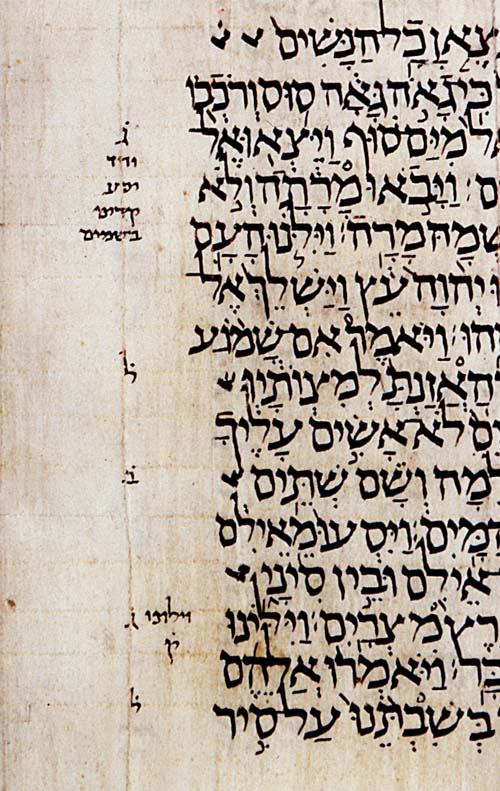|
Nash Papyrus
The Nash Papyrus is a collection of four papyrus fragments acquired in Egypt in 1902, inscribed with a Hebrew text which mainly contains the Ten Commandments and the first part of the Shema Yisrael prayer, in a form that differs substantially from the later, canonical Masoretic text and is in parts more similar to the chronologically closer Septuagint. It has been suggested that the text might have been the daily worship of a Jew living in Egypt at the time. The fragments comprise a single sheet and are not part of a scroll. The papyrus is of unknown provenance, although it is allegedly from Fayyum. The text was first described by Stanley A. Cook in 1903. Though dated by Cook to the 2nd century CE, subsequent reappraisals have pushed the date of the fragments back to about 150–100 BCE. The papyrus was by far the oldest Hebrew manuscript fragment known at that time, before the discovery of the Dead Sea Scrolls in 1947. Discovery The papyrus fragments were acquired by W. L. Nash ... [...More Info...] [...Related Items...] OR: [Wikipedia] [Google] [Baidu] |
Pentateuch
The Torah (; hbo, ''Tōrā'', "Instruction", "Teaching" or "Law") is the compilation of the first five books of the Hebrew Bible, namely the books of Genesis, Exodus, Leviticus, Numbers and Deuteronomy. In that sense, Torah means the same as Pentateuch or the Five Books of Moses. It is also known in the Jewish tradition as the Written Torah (, ). If meant for liturgic purposes, it takes the form of a Torah scroll (''Sefer Torah''). If in bound book form, it is called '' Chumash'', and is usually printed with the rabbinic commentaries (). At times, however, the word ''Torah'' can also be used as a synonym for the whole of the Hebrew Bible or Tanakh, in which sense it includes not only the first five, but all 24 books of the Hebrew Bible. Finally, Torah can even mean the totality of Jewish teaching, culture, and practice, whether derived from biblical texts or later rabbinic writings. The latter is often known as the Oral Torah. Representing the core of the Jewish spi ... [...More Info...] [...Related Items...] OR: [Wikipedia] [Google] [Baidu] |
Hebrew Bible Manuscripts
A biblical manuscript is any handwritten copy of a portion of the text of the Bible. Biblical manuscripts vary in size from tiny scrolls containing individual verses of the Jewish scriptures (see ''Tefillin'') to huge polyglot codices (multi-lingual books) containing both the Hebrew Bible (Tanakh) and the New Testament, as well as extracanonical works. The study of biblical manuscripts is important because handwritten copies of books can contain errors. Textual criticism attempts to reconstruct the original text of books, especially those published prior to the invention of the printing press. Hebrew Bible (or Tanakh) manuscripts The Aleppo Codex (c. 920 CE) and Leningrad Codex (c. 1008 CE) were once the oldest known manuscripts of the Tanakh in Hebrew. In 1947, the finding of the Dead Sea scrolls at Qumran pushed the manuscript history of the Tanakh back a millennium from such codices. Before this discovery, the earliest extant manuscripts of the Old Testament were in Greek ... [...More Info...] [...Related Items...] OR: [Wikipedia] [Google] [Baidu] |
William F
William is a masculine given name of Norman French origin.Hanks, Hardcastle and Hodges, ''Oxford Dictionary of First Names'', Oxford University Press, 2nd edition, , p. 276. It became very popular in the English language after the Norman conquest of England in 1066,All Things William"Meaning & Origin of the Name"/ref> and remained so throughout the Middle Ages and into the modern era. It is sometimes abbreviated "Wm." Shortened familiar versions in English include Will, Wills, Willy, Willie, Liam, Bill, and Billy. A common Irish form is Liam. Scottish diminutives include Wull, Willie or Wullie (as in Oor Wullie or the play ''Douglas''). Female forms are Willa, Willemina, Wilma and Wilhelmina. Etymology William is related to the German given name ''Wilhelm''. Both ultimately descend from Proto-Germanic ''*Wiljahelmaz'', with a direct cognate also in the Old Norse name ''Vilhjalmr'' and a West Germanic borrowing into Medieval Latin ''Willelmus''. The Proto-Germa ... [...More Info...] [...Related Items...] OR: [Wikipedia] [Google] [Baidu] |
List Of Hebrew Bible Manuscripts
A Hebrew Bible manuscript is a handwritten copy of a portion of the text of the Hebrew Bible (Tanakh) made on papyrus, parchment, or paper, and written in the Hebrew language. (Some of the Biblical text and notations may be in Aramaic.) The oldest manuscripts were written in a form of scroll, the medieval manuscripts usually were written in a form of codex. The late manuscripts written after the 9th century use the Masoretic Text. The important manuscripts are associated with Aaron ben Asher (especially Codex Leningradensis). The earliest sources (whether oral or written) of the Hebrew Bible disappeared over time, because of the fragility of media, wars, (especially the destruction of the First and Second Temples), and other intentional destructions. As a result, the lapse of time between the original manuscripts and their surviving copies is much longer than in the case of the New Testament manuscripts. The first list of the Old Testament manuscripts in Hebrew, made by Benjami ... [...More Info...] [...Related Items...] OR: [Wikipedia] [Google] [Baidu] |
Tefillin
Tefillin (; Modern Hebrew language, Israeli Hebrew: / ; Ashkenazim, Ashkenazic pronunciation: ), or phylacteries, are a set of small black leather boxes with leather straps containing scrolls of parchment inscribed with verses from the Torah. Tefillin are worn by adult Jews during weekday morning prayers. In Orthodox Judaism, Orthodox and traditional communities, they are worn solely by men, while some Reform Judaism , Reform and Conservative Judaism, Conservative (Masorti) communities allow them to be worn by both men and women. By traditional Jewish Law (halacha), women are exempt from most time-dependent positive commandments. Although "tefillin" is technically the plural form (the singular being "tefillah"), it is often used as a singular as well. The arm-tefillah (or ''shel yad'' [literally "of the hand"]) is placed on the upper (non-dominant) arm, and the strap wrapped around the forelimb, hand and middle finger; while the head-tefillah (or ''shel rosh'' [literally "of the ... [...More Info...] [...Related Items...] OR: [Wikipedia] [Google] [Baidu] |
Liturgy
Liturgy is the customary public ritual of worship performed by a religious group. ''Liturgy'' can also be used to refer specifically to public worship by Christians. As a religious phenomenon, liturgy represents a communal response to and participation in the sacred through activities reflecting praise, thanksgiving, remembrance, supplication, or repentance. It forms a basis for establishing a relationship with God. Technically speaking, liturgy forms a subset of ritual. The word ''liturgy'', sometimes equated in English as "service", refers to a formal ritual enacted by those who understand themselves to be participating in an action with the divine. Etymology The word ''liturgy'' (), derived from the technical term in ancient Greek ( el, λειτουργία), ''leitourgia'', which literally means "work for the people" is a literal translation of the two words "litos ergos" or "public service". In origin, it signified the often expensive offerings wealthy Greeks made in ser ... [...More Info...] [...Related Items...] OR: [Wikipedia] [Google] [Baidu] |
The Jewish Quarterly Review
''The Jewish Quarterly Review'' is a quarterly peer-reviewed academic journal covering Jewish studies. It is published by the University of Pennsylvania Press on behalf of the Herbert D. Katz Center for Advanced Judaic Studies (University of Pennsylvania). The editors-in-chief are David N. Myers (UCLA) and Natalie Dohrmann (University of Pennsylvania). It is available online through Project MUSE and JSTOR. The journal was established in London in 1889 by Israel Abrahams and Claude G. Montefiore as an English-language concurrent of the French '' Revue des études juives'', itself an outgrowth of the Wissenschaft des Judentums movement. It is the oldest English-language journal of Judaic scholarship. References External links * The Jewish Quarterly Reviewat JSTOR JSTOR (; short for ''Journal Storage'') is a digital library founded in 1995 in New York City. Originally containing digitized back issues of academic journals, it now encompasses books and other primary sourc ... [...More Info...] [...Related Items...] OR: [Wikipedia] [Google] [Baidu] |
Francis Crawford Burkitt
Francis Crawford Burkitt (3 September 1864 – 11 May 1935) was an English theologian. As Norris Professor of Divinity at the University of Cambridge from 1905 until shortly before his death, Burkitt was a sturdy critic of the notion of a distinct " Caesarean Text" of the New Testament put forward by B. H. Streeter and others. Education and career Burkitt was educated at Harrow School. He studied mathematics at Trinity College, Cambridge, graduating with a Bachelor of Arts (BA) degree in 1886: he was the 28th Wrangler that year. He then undertook the theological tripos and gained first-class honours in 1888. He received his Master of Arts (MA) in 1890. He was awarded both Bachelor of Divinity (BD) and Doctor of Divinity (DD) degrees in 1915. From 1903 to 1905, he was a lecturer in palaeography at the University of Cambridge. He was Norrisian Professor of Divinity from 1905 to 1934, and then Norris–Hulse Professor of Divinity from 1934 until his death in 1935. In 1 ... [...More Info...] [...Related Items...] OR: [Wikipedia] [Google] [Baidu] |
Talmud
The Talmud (; he, , Talmūḏ) is the central text of Rabbinic Judaism and the primary source of Jewish religious law ('' halakha'') and Jewish theology. Until the advent of modernity, in nearly all Jewish communities, the Talmud was the centerpiece of Jewish cultural life and was foundational to "all Jewish thought and aspirations", serving also as "the guide for the daily life" of Jews. The term ''Talmud'' normally refers to the collection of writings named specifically the Babylonian Talmud (), although there is also an earlier collection known as the Jerusalem Talmud (). It may also traditionally be called (), a Hebrew abbreviation of , or the "six orders" of the Mishnah. The Talmud has two components: the Mishnah (, 200 CE), a written compendium of the Oral Torah; and the Gemara (, 500 CE), an elucidation of the Mishnah and related Tannaitic writings that often ventures onto other subjects and expounds broadly on the Hebrew Bible. The term "Talmud" may refer to ... [...More Info...] [...Related Items...] OR: [Wikipedia] [Google] [Baidu] |
Canaan
Canaan (; Phoenician: 𐤊𐤍𐤏𐤍 – ; he, כְּנַעַן – , in pausa – ; grc-bib, Χανααν – ;The current scholarly edition of the Greek Old Testament spells the word without any accents, cf. Septuaginta : id est Vetus Testamentum graece iuxta LXX interpretes. 2. ed. / recogn. et emendavit Robert Hanhart. Stuttgart : Dt. Bibelges., 2006 . However, in modern Greek the accentuation is , while the current (28th) scholarly edition of the New Testament has . ar, كَنْعَانُ – ) was a Semitic-speaking civilization and region in the Ancient Near East during the late 2nd millennium BC. Canaan had significant geopolitical importance in the Late Bronze Age Amarna Period (14th century BC) as the area where the spheres of interest of the Egyptian, Hittite, Mitanni and Assyrian Empires converged or overlapped. Much of present-day knowledge about Canaan stems from archaeological excavation in this area at sites such as Tel Hazor, Tel Megiddo, E ... [...More Info...] [...Related Items...] OR: [Wikipedia] [Google] [Baidu] |

.jpg)




